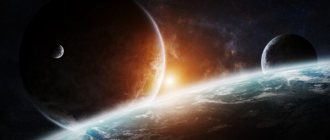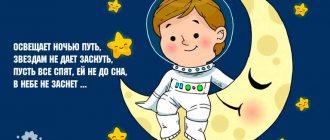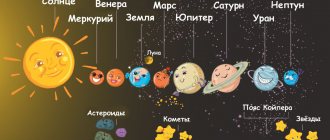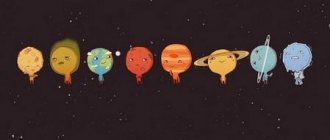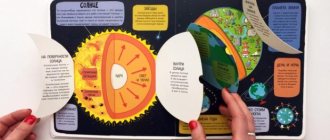Project “What do I know about the history of space exploration?”
- May 10, 2011
Competition "Children's Research Project"
Nomination "The world around us"
Project objectives:
- Introduction to the history of space exploration.
- Fostering a sense of patriotism and pride in one’s past and present, creating independent ideas about the worthy global significance and self-worth of Russia.
- Mastering new forms of searching, processing and analyzing information.
- Development of communication and organizational skills.
- Improving group and individual work skills.
Steps to work on the project:
- Creation of an initiative group responsible for the development and implementation of the project. Identification of the project manager: Artushenko N.V., primary school teacher.
- The formulation of the goal of the project is to expand students’ knowledge about astronautics, its founders, the first manned flight into space; nurturing a sense of patriotism, pride for our Motherland - a great space power - and our compatriots, in whose honor the anniversary date is celebrated - the 50th anniversary of Cosmonautics Day.
- Defining tasks that will achieve the project goal.
- Determining priority activities that are necessary to solve problems.
- Development of a project implementation plan.
- Determining the necessary resources and drawing up the project budget, taking into account existing own resources and resources that need to be attracted.
Program of activities carried out within the framework of the project:
- Lecture for parents “Space for Children”;
- a drawing competition dedicated to the celebration of the 50th anniversary of Cosmonautics Day;
- extracurricular activity “Dunno – an astronaut or...”;
- class hours “Dear Gagarin” and “Cosmonautics Day”;
- extracurricular event “Starry Distances”;
- Quiz "Cosmic ABC".
Results:
1. The knowledge base of students in grades 2-4 of our school was replenished with information about the history of space exploration - during the quiz held as part of the project, not a single question asked was left unanswered.
2. 2nd grade students - members of the project initiative group - gained experience in research work, as well as experience in conducting various events not only in the classroom, but also outside it. In the process of preparing and conducting project events, our class became more friendly.
Appendix: Presentation “What do I know about the history of space exploration?” (2.8 MB).
Photo by the author
Author: A team of students consisting of: Danil Antakov, Ruslan Balashov, Evgenia Vedomskaya, Alexandra Gough, Danil Kabanov, Dmitry Mamontov, Ivan Matyushin, Ilya Motorin, Danil Nikolaev, Dmitry Papakoy, Ivan Chernyshev, Natalya Shulga, 2nd grade students of the Sedelnikovskaya Secondary School No. 1", Sedelnikovo village, Omsk region. Head: Natalya Viktorovna Artushenko, primary school teacher of the second qualification category, Municipal Educational Institution “Sedelnikovskaya Secondary School No. 1”, Sedelnikovo village, Omsk Region. Total experience - 9 years, length of service - 8 months.
Project “This Mysterious Space”
Relevance of the project
Since ancient times, people have been interested in the sky and stars. Our ancestors were well versed in the “habits” of the sky. This is the interest and knowledge of the older preschoolers attending our group...
How to maintain interest in the unknown? I believe that the project method will allow children to learn complex material through a joint search for solutions to problems. Work on the project is complex in nature, permeates all types of activities of preschoolers, takes place in everyday life and in the classroom.
The content of the classes is age-appropriate and gives children the ability to express their emotional experiences and master knowledge about space.
Routing
| Content | Explanation |
| Subject | "This mysterious space" |
| Type | Information and research |
| View | Short |
| Project participants | Preschool employees, children, parents |
| Implementation period | From April 1 to April 12, 2015 |
| Target | To form in children the idea that we live in Russia on planet Earth, and that besides Earth there are other planets in space in the solar system, they should know that the first person to go into space on a Vostok rocket was a Russian and be proud of the fact that they are Russians too. |
| Tasks | 1. Continue to expand the understanding of children and parents about the diversity of space and the history of the development of astronautics. 2. To consolidate the first ideas about the Universe as a whole and about the planets of the Solar system, their features, location relative to the Sun. Give an idea of the Moon as the only satellite of the Earth. 3. To form elementary ideas about the relationship of living organisms with the change of day and night. 4. Deepen and systematize children’s knowledge about aircraft and animals that have conquered space. 5. To cultivate a caring attitude towards the beauty of the surrounding world, love and respect for the astronaut profession, for the country, and its achievements. |
| Basis for the development of the project | Children's superficial knowledge about space, about the first man to fly into space, about the existence of a holiday in Russia - Cosmonautics Day. Insufficient attention of parents to the Russian holiday - Cosmonautics Day. |
| Expected result | Children will develop knowledge about space, outer space, the relationship of living organisms with the change of day and night, seasons, and will have a desire to know more about space. Children will learn the names of the first astronauts and will respect the astronaut profession. They will learn why life exists on Earth (they must learn to admire nature and treat it with care) |
| Working with parents | 1. Production jointly by parents and children of a model of the “Solar System” and a telescope. 2. Selection of literature on the topic. 3. Providing assistance in leisure activities. 4. Memorizing poems, riddles, physical exercises on the topic. 5. Studying the thematic folder “Different planets”. |
Project work plan
| Period of execution | Contents of work | Responsible |
| April 1 | Creating a problematic situation for children | Teachers and children |
| April 2 | 1. Design of the folder - movements on the topic of the project. 2. Consultation for parents on the topic: “The role of the family in the development of the child’s search and research activity” | Teachers, parents |
| April 3 | 1. Conversation on the topic “Where does the sun spend the night? Why is there winter and summer? » 2. Selection of fiction and illustrations on the topic. 3. Memorizing the poem by Y. Akim: “Earth” | Teachers, children, parents |
| April, 4 | 1. Morning conversation-dialogue about astronauts. Reading the story by M.A. Poznanskaya “About Belka and Strelka and their journey” 2. Review of books and encyclopedias about space. 3. Making binoculars and telescopes from waste material | Teachers, parents, children |
| 5th of April | 1. Experiment with a globe and a lamp: “Day - Night” 2. Acquaintance with new poems, riddles about space 3. Reading A. Leonov “How a boy became an astronaut” | Teachers, children |
| April 8 | 1. Construction of rockets from modules. 2. Presentation "Space" | Teachers, children |
| April 9 | 1. Compilation of stories about the planets. 2. Reading A. Leonov “I’m going into space” 3. Making a model: “Solar system” | Teachers, children |
| April 10th | 1. Conversation on the topic “The concept of the fragility of the world and the Solar Kingdom” 2. Drawing on the theme: “Space” 3. Story-role-playing game: “Flight to the Moon” | Teachers, children |
| 11 April | 1. Compilation of stories “Our Planet Earth” 2. Watching the cartoon “The Secret of the Third Planet” 3. Outdoor game “Take a seat in the rocket” | Teachers, children |
| 12th of April | 1. Exhibition of drawings on the topic 2. Sports entertainment: “Flight into space” | Teachers, children, parents |
Final result of the project:
Work on the project was carried out with the direct assistance of parents and teachers working in the group. During this period, the children learned a lot about space, about astronauts, and with great pleasure, together with their parents, looked for material in the library and on the Internet, made drawings and crafts from waste material.
The project gives the child the opportunity to experiment, synthesize acquired knowledge, develop creativity and communication skills, create and explore together with adults, which allows him to successfully adapt to the school learning situation and the world around him.
Such activities, games, and productive activities unite children with common impressions, experiences, emotions, and contribute to the formation of a sense of pride in their country. Children become interested in independently searching for answers in various sources of information, and the motivational component increases: children ask more questions and are interested in educational literature.
Together with the teachers, with the help of their parents, they made a model of the solar system, which was used in research work and in classes.
Guessing and inventing riddles about space and planets; Used in games and invented counting rhymes;
Examination of photos, illustrations, pictures;
Children drew on the theme: “Cosmonautics Day
We made attributes for games.
We completed a group project using waste material:
Children experimented, systematized their knowledge, developed creativity and communication skills.
The result of the work on the project was the sports entertainment “Flight into Space”.
After participating in the project, children look around more carefully and make amazing discoveries, notice interesting things in the familiar and inconspicuous. Having learned about the Universe, the children learned to find a wide strip of the Milky Way, constellations, and planets in the night sky. Maybe they will want to tell their friends what the guys learned about. This is wonderful! Let what has been told become for our children and their friends the first island, the first “circle” in the boundless sea of knowledge.
Literature.
Borisenko M.G., Lukina N.A. Space. Grammar in pictures. - St. Petersburg, 2005.
Preschool education, 2010. No. 5. – C40-45.
From birth to school. Sample basic general education program for preschool education. /ed. Veraksy N.E., Komarova T.S., Vasilyeva M.A. – M., 2010.
Skorolupova O.A. Classes for senior preschool children on the topic “Conquest of Space.” M., 2003.
Skorolupova O.A. Big space journey: Game week at preschool educational institutions. – M., 2003.
Project work: This mysterious space
Irina Kirichenko
Project work: This mysterious space
Project work on the topic:
«This mysterious space»
Introduction
Relevance of the project
“Humanity will not remain on earth forever, but, in pursuit of light and space, it will first timidly penetrate beyond the atmosphere, and then conquer the entire circumsolar space” (K. Tsiolkovsky)
.
Several decades ago, few of yesterday's boys did not want to become an astronaut . This dream is not at all important for modern children. Meanwhile, space pirates , Star Wars participants and other alien creatures are the heroes of their favorite cartoons. Fictional characters misinform preschoolers by telling them about non-existent planets, and often evoke negative emotions in them and contribute to the development of fears. Therefore, now it is important to competently organize work to develop children’s ideas about space .
Interest in Space awakens in a person very early, literally from the first steps. The mysteries of the Universe always excite the imagination, from early childhood to old age. The sun, the moon, the stars are at the same time so close, and at the same time so far away. Remember your childhood, how interesting it was to look at the night sky. How to support a child's interest in the unknown? Using what methods can you interest a child and help him learn new, interesting information about space ? I believe that the project will allow children to learn complex material through a joint search for a solution to a problem, thereby making the learning process interesting and motivational. Work on the project is complex in nature, permeates all types of activities of preschoolers, takes place in everyday life and in special integrated classes. Otherwise, children's knowledge will remain confused, fragmentary, incomplete, and disconnected from modern life. Project activities develop children’s creative activity and help the teacher himself develop as a creative person. project based on preschoolers’ thirst for knowledge, desire for discovery, curiosity, need for mental impressions, and my task is to satisfy the needs of children, which in turn will lead to intellectual and emotional development. This project is aimed at developing children’s horizons, developing their cognitive activity, nurturing patriotic feelings (pride in Russian cosmonauts space pioneers , moral values (good, friendly relations, etc.)
.
The following approaches were used to implement the project
— in the process of cooperation and interaction, communication skills develop, dialogical speech develops;
— joint productive creative activity creates an atmosphere of goodwill, mutual assistance, and a favorable emotional climate;
— by implementing the project , participants in the educational process “parents – children – educators” create a triad of commonwealth;
- children develop their own, personal attitude towards what they see and hear, a feeling of joy from contact with , etc. d.
Objective of the project :
outer space human space exploration in older preschool children .
Project objectives :
For children
expand children's knowledge about Cosmonautics ;
Yuri Alekseevich Gagarin’s first flight into space
expand knowledge about space , systematize ideas about the Universe, the Solar system and its planets;
to form cognitive interests;
develop creative imagination, imagination;
activate the vocabulary: sky, stars, planets, satellites, space , astronaut , Sun, Earth, Moon;
enrich the vocabulary: Galaxy, Universe, Solar system, Mercury, Venus, Mars, Jupiter, Saturn, Uranus, Neptune, Pluto, weightlessness, orbit, spacesuit, meteorite, asteroid;
encourage word creation and composing descriptive stories;
form an idea of yourself as an inhabitant of planet Earth;
develop mathematical abilities through experimental activities, through logical tasks and educational games;
develop experimental activities and experimentation;
to cultivate respect for the difficult and dangerous profession of astronaut .
For teachers
ensure the implementation of educational, developmental and educational tasks through children’s mastery of educational areas;
create conditions for independent and joint activities of children with adults within the framework of the ongoing project ;
contribute to the establishment of friendly relationships between teachers and specialists of preschool educational institutions, parents in the process of development and implementation of the project ;
For parents
to attract parents to the problem of developing the child’s cognitive sphere, using the creation of homemade books, participation in the creation of a rocket from waste material, composing stories on the theme “My Planet”
, coming up with a costume for
an astronaut ;
promote the establishment of partnerships between parents and teachers in matters of upbringing and education of children.
Project duration : 1.5 months (medium term)
.
Type of project : educational-research, creative.
Project participants : children of different age groups for children with mental retardation, educators, parents of pupils, a speech pathologist, a psychologist, teachers of additional education: drawing, art therapy.
Planned results:
• Children’s development of basic knowledge on the topic “ Space ”
;
• Formation of moral and patriotic feelings in the process of project ;
• Children's interest in the topic of space , manifestation of their cognitive activity: together with their parents, they find information on the topic, tell and share their knowledge with other children in kindergarten.
• Children's initiative design of rockets from building material, waste material, construction sets, paper according to their own ideas, manifestation of creativity and detail in their work .
• The opportunity to participate in a project , where children will be able to apply their existing knowledge about space , cosmic phenomena , participate in fun contests and competitions, and present their drawings and crafts.
Form of conducting the final event of the project : integrated leisure “Great Space Journey ”
.
Project content
Stages of work on the project .
Stage I (preparatory)
1. Identifying children’s initial knowledge about space . Informing parents about upcoming activities (at a parent meeting, building a rocket from waste material together with the children);
2. Development of a thematic project on the topic : “ Space ”
for children and adults;
3. Creation of computer presentations;
4. Exhibition of books, encyclopedias. Selection of fairy tales, poems, riddles on the topic , music;
5. Design of an information corner for children, a calendar counting the number of days remaining until the holiday;
6. Selection of materials for parents: folders, photo newspapers;
7. Selection and recommendations for reading literature with children;
8. Making a card index of outdoor games, physical education minutes, dynamic breaks on the topic;
9. Preparation of coloring pages, shading, stencils in accordance with age.
Stage II ( project )
Drawing (crayons)
on the topic:
“
Space distances ” .
Modeling "Rocket launch site"
.
Application " Space flight "
.
Artistic work “On a distant planet”
(crafts made from paper, cardboard and waste materials)
Construction from building materials and designer parts: according to a sample (diagram, drawing, model)
.
Construction of rockets from boxes and waste material.
Conversations using presentations.
1. Conversation “What is space ”
.
Goal: to give children an idea of the planets of the solar system, the sun, stars, the first flight into space , to find out children’s knowledge on this issue.
2. Conversation “Blue Planet - Earth”
.
Goal: explain to children what a telescope is, outer space , show how beautiful our Earth is from space .
3. Conversation “The Moon is a satellite of the Earth”
.
Goal: to find out children’s ideas about the Moon, the month, to expand knowledge about the lunar surface and atmosphere.
4. Conversation “Family of Planets”
.
Goal: to expand children’s understanding of the planets of the solar system.
5. Conversation “The Sun is the source of life on Earth”
.
Purpose: to clarify children’s knowledge about the sun, its shape; explain what it consists of.
Conducting experiments: “Properties of water”
,
“What is weightlessness?”
.
Design of the thematic exhibition “I, too,
will fly into space . ”
Didactic games, intellectual, educational games: “Cut pictures”
,
“Journey into
space ” ,
“Name the constellation”
,
“Recognize the planet”
,
“What comes first, what comes next”
,
“Put in order”
,
“Assemble a rocket”
.
Role-playing, director's games: " Space Rescuers "
,
“Selection
of astronauts ” ,
“Flight to the moon”
,
“
Space cafe ” .
Outdoor games, physical education sessions, finger games (card file, see appendix)
Involving parents in the educational process of preschool educational institutions: - joint leisure time building a rocket, exhibition of joint creativity “My Planet”
, making a spacesuit.
Project products :
For children
homemade books “My Planet”
, compiling a story for them;
creating a rocket model from waste material;
applique " Space rocket "
;
modeling " Cosmodrome "
;
drawing with wax crayons “ Space distances ”
;
art therapy “On a distant planet”
.
For teachers
• development of a thematic project on the topic : “ Space ”
for children and adults; creation of computer presentations;
• making a card index of outdoor games, physical education minutes, dynamic pauses on the topic, attributes for them (See Appendix)
For parents
• creation of an astronaut .
Stage III (final)
At the final stage of the project, the final event “Great Space Journey ”
.
It consolidated the basic knowledge gained and summed up the entire project .
The diagnostic results showed that at the initial stage of work 4 children showed a relatively high level of knowledge (25%), 7 children had knowledge at an average level (43.75%, a very low level - 3 children (18.75%)
.
Children's knowledge about space was superficial and fragmentary, obtained mainly from cartoons; children named 1-2 planets, did not know the name of the first cosmonaut , and had little idea what people do in space . The final diagnostics showed that children’s knowledge about outer space and about space was systematized; their active vocabulary was enriched due to the introduction of new words in cognitive classes and their use in other types of activities: in games, discussion of illustrations, productive activities, etc. The children saw how significant the problem of space is for the country and felt involved in it. The results of the final diagnosis: 10 children showed a high level (62.5%, an average level - 6 children (37.5%), a low level: 0 children (0% )
The practical significance of the project is that can use it in their work , adapting its content to the conditions of their preschool educational institution and the possibility of interaction with society.
Conclusion
The development of cognitive interest in various areas of knowledge and activities is one of the components of the success of teaching children in kindergarten. A preschooler's interest in the world around him, the desire to learn and master everything new is the basis for the formation of this quality.
Intensive changes in the surrounding life, the active penetration of scientific and technological progress into all its spheres dictate the teacher the need to choose more effective means of teaching and education based on modern methods and new integrated technologies.
One of the promising methods that helps solve this problem is the project activity . Based on a personality-oriented approach to training and education, it develops cognitive interest in various areas of knowledge and develops cooperation skills.
A project as an independent and collective creative completed work that has a socially significant result. based on a problem ; solving it requires research in various directions, the results of which are generalized and combined into one whole.
project method can be used in working with older preschoolers. This age stage is characterized by more stable attention, observation, the ability to begin analysis, synthesis, self-esteem, as well as the desire for joint activities. The project can combine educational content from various fields of knowledge; in addition, it opens up great opportunities for organizing joint cognitive-search activities of preschoolers, teachers and parents.
The topics and content of projects for children of senior preschool age can be very diverse.
Having completed work on this project , it can be argued that by creating certain conditions and using various forms and methods of work , as well as by including interested adults in the project : teachers and parents, it is quite possible for children to master basic knowledge about space .
Bibliography
1. Sample educational program for preschool education “Childhood”
St. Petersburg CHILDHOOD PRESS. – 2014.
2. Yu. A. Vakulenko Complex entertaining activities for children 4-5 years old, publishing house "Teacher"
. – 2007.
3. G. Yurmin, A. Dietrich. Because. Fun encyclopedia. - Moscow. — 1999.
4. Kalashnikov V. About stars and planets.
5. Space . Children's encyclopedia. - Moscow. - 2000.
6. Leonov A. I’m going into space . - Moscow. — 1985.
7. Levitan E. P. Kids about stars and planets. - Moscow. — 1981.
8. Why. Ed. A. Aleksina. - Moscow. — 1992.
9. Skorolupova O. A. Conquest of space . – 2nd ed., Moscow. – 2007.
